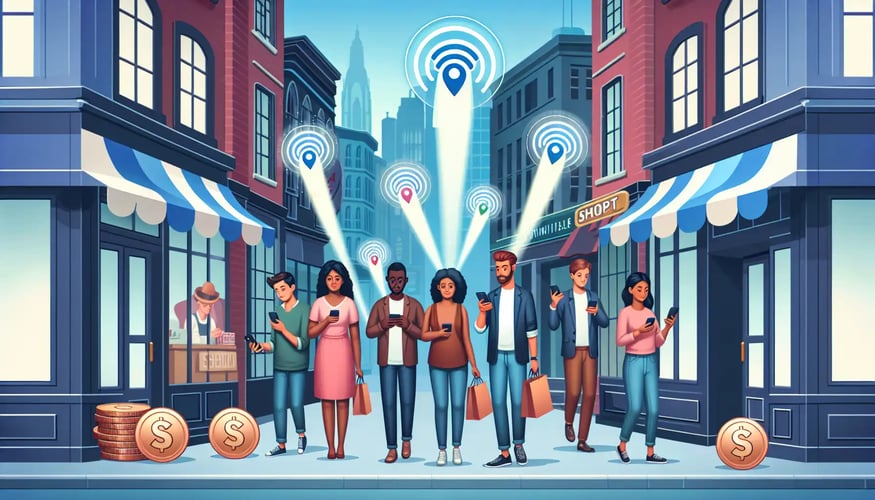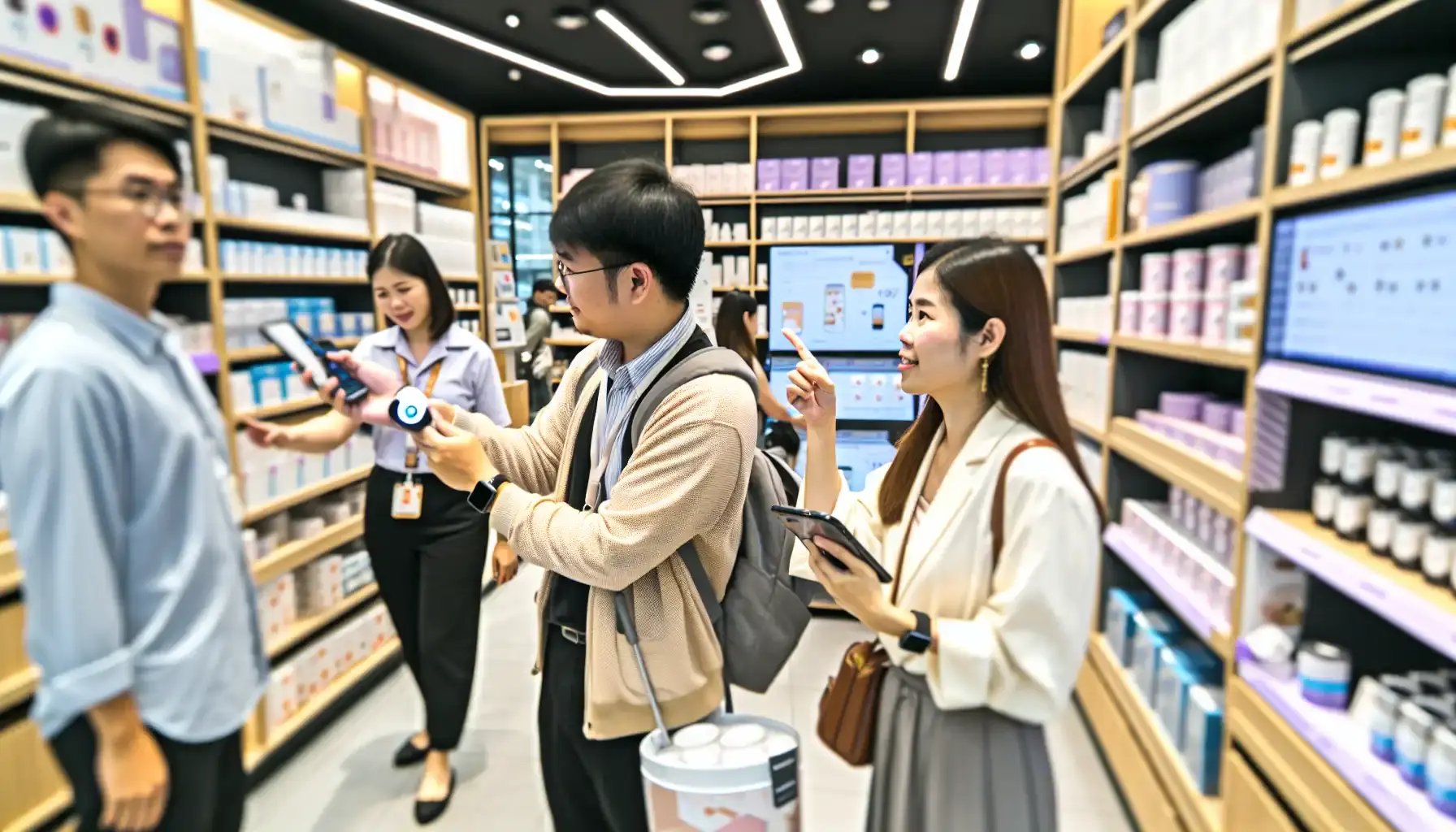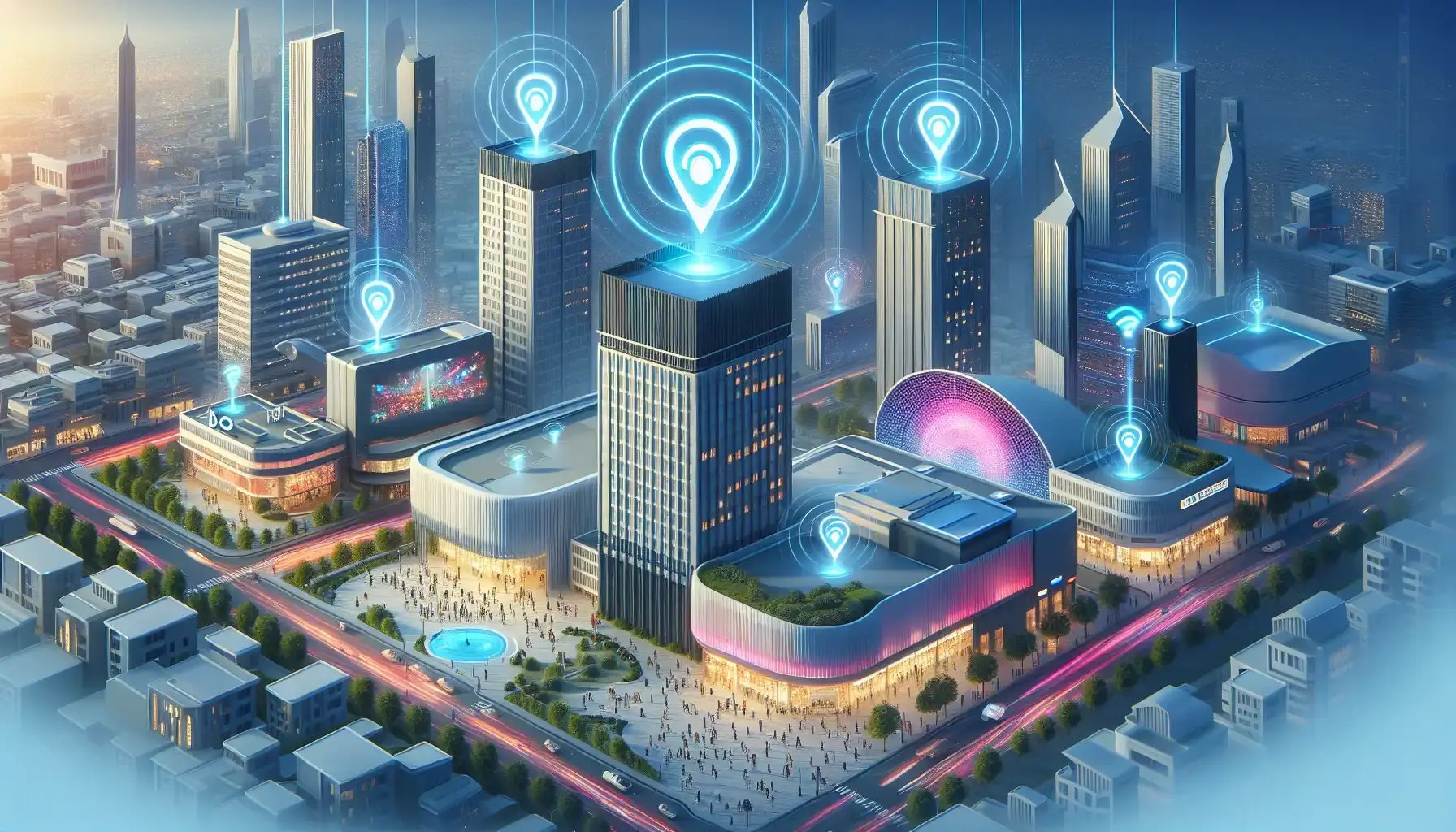The main purpose of beacon software is to facilitate proximity marketing, which involves sending out notifications containing coupons or displaying relevant in-app content based on nearby events. This technology relies on beacons to transmit the signals and connect with users’ devices for targeted marketing strategies.

January 29, 2024
| Last updated on October 1, 2024
Beacon Technology: Enhanced Customer Engagement
Written by Marc Alringer
Overview
-
Beacons use Bluetooth to send personalized messages and gather data on customer behavior. iBeacon and Eddystone are the main types of beacons.
-
Beacons facilitate enhanced engagement in various industries by delivering targeted information and insights into consumer behavior.
-
We cover advantages and challenges of BLE. Some advantages are cost-effectiveness and enhanced customer engagement while some challenges are privacy concerns and app dependency.
Time to read: 13 min
Table of Contents +
- What is Beacon Technology?
- Advantages of Utilizing Beacon Devices
- Challenges in Beacon Deployment
- Beacon Technology Across Industries
- Implementing Beacon Strategies in Retail
- Beacon Technology in Healthcare
- Beacon Technology in the Travel Industry
- Beacon Technology in the Hospitality Industry
- Future Trends in Beacon Tech Development
- Summary
- Frequently Asked Questions (FAQ's)
What is Beacon Technology?
BLE beacon technology relies on Bluetooth Low Energy (BLE), a more efficient version of classic Bluetooth, to power its functionality. Initially introduced in 2010, BLE’s low energy consumption is essential for beacons to communicate with mobile devices without draining their battery life. These wireless transmitters called “beacons” are small but powerful tools that transmit signals and engage with customers when they come within proximity.
Proximity marketing is the primary use case for beacon technology, particularly through the utilization of mobile beacons. The concept works by transmitting unique ID numbers from these beacons, which are then received by specific apps installed on users’ smartphones or tablets.
As a result, actions such as delivering personalized advertisements or gathering data about user behavior can easily occur in real-time based on location-based triggers set up by businesses utilizing this technology. This ability opens up endless possibilities for enhancing customer engagement and driving sales using targeted content delivered right at their fingertips via BLE-enabled smart devices.
WHO ARE WE? EXPERT MOBILE APP DEVELOPERS
-
At Seamgen, we have over a decade of experience working with client requests and requirements to determine the best framework for their specific needs.
-
We partner with clients ranging from start-ups to fortune 500 clients building mobile apps, including BLE location systems projects through our custom mobile app development services.
-
USA Design Led Development Agency based in San Diego, CA.
-
We invite you to call us for a free project consultation.
The Mechanics of Beacons
BLE beacons broadcast a unique identifier, allowing compatible mobile apps to trigger location-based actions. This enables proximity sensing within the smart devices ecosystem. The physical form of beacon devices can range from small coin cell gadgets to USB sticks and dongles, with power sources including batteries, USB cords or mains electricity.
Beacon ranges can reach up to 70 meters but may vary due to factors like obstructions and device shape. When deploying bluetooth beacons for effective communication with target devices, these variables should be considered carefully.
Beacon Protocols: iBeacon and Eddystone
iBeacon and Eddystone are the dominant protocols for beacons. Initially launched by Apple in 2013, iBeacon is a closed system that uses a simple code structure. In contrast, Google’s Eddystone was introduced in 2015 as an open platform with more intricate architecture to allow developers to customize and update their codes.
Though initially developed only for iOS devices, iBeacon now also works on Android devices. It transmits identifiers like UUID, Major, and Minor through Bluetooth Low Energy (LE). On the other hand,ddystone can work across all BLE operating systems and transmit various data packets such as UID, URL, and TLM.Between choosing between iBeacon andddystone, the decision mainly depends on the specific needs and goals of businesses.

Marc Alringer
President/Founder, Seamgen
Marc Alringer, the visionary President and Founder of Seamgen, has been at the forefront of digital transformations, specializing in web and mobile app design and development. A proud alumnus of the University of Southern California (USC) with a background in Biomedical and Electrical Engineering, Marc has been instrumental in establishing Seamgen as San Diego's top custom application development company. With a rich history of partnering with Fortune 500 companies, startups, and fast-growth midsize firms, Marc's leadership has seen Seamgen receive accolades such as the Inc 5000 and San Diego Business Journal’s “Fastest Growing Private Companies”. His expertise spans a wide range of technologies, from cloud architecture with partners like Microsoft and Amazon AWS, to mobile app development across platforms like iOS and Android. Marc's dedication to excellence is evident in Seamgen's impressive clientele, which includes giants like Kia, Viasat, Coca Cola, and Oracle.
Advantages of Utilizing Beacon Devices
Businesses can benefit from a multitude of advantages offered by beacon devices. One of the most significant benefits of beacon technology is their cost-effectiveness. Beacons allow businesses to:
-
Deliver tailored customer experiences without heavy investment
-
Deliver personalized, location-based content
-
Implement user-focused proximity marketing
-
Significantly improve advertising results
Advancements in Bluetooth Low Energy are further enhancing beacon capabilities, expanding their applications in proximity marketing and indoor navigation. Also, beacon devices demonstrate versatility by supporting different business strategies. They:
-
Facilitate secure and convenient mobile payment systems
-
Enhance visibility online by facilitating customer check-ins and reviews
-
Play a crucial role in improving local SEO
Cost-Effective Marketing Solutions
Another one of the benefits of beacon technology is the value for increasing sales, no matter the size of a business. It offers an affordable solution to targeted marketing and has proven effective in driving sales. Retail stores can take advantage of beacon technology’s affordability, easy installation process, and reliable customer engagement capabilities. In fact, it is projected that by 2025, $44.4 billion worth of retail sales will be influenced by beacon-activated messages.
By utilizing beacon devices, in-store traffic can be increased while also boosting online advertising results which could potentially lead to higher ROI for companies using this technology.
To real-time promotional notifications attracting customers and encouraging store visits, API platforms like PlotRewards Enhance the possibilities with their ability to provide app users access to all the latest local deals and discounts through integration with beacons.
Enhancing Customer Experiences
Beacons can greatly improve customer experiences by providing personalized notifications and promotions. They also help bridge the gap between online and offline channels, drive conversions through targeted advertising, and utilize data collected from Bluetooth beacon interactions to enhance staff efficiency and refine marketing strategies based on customer-centric information.
Engaging users through beacon notifications may face obstacles such as Bluetooth being disabled or users ignoring the messages. These challenges can be overcome by personalizing app content and rewards according to user behavior in order to increase usefulness of apps which ultimately results in more downloads.
The varying distances at which Bluetooth beacons operate allow for different types of interactions, making it possible for proximity marketing campaigns that use location-based messages to boost loyalty among customers and encourage greater engagement with apps.
Challenges in Beacon Deployment
Even though beacon technology offers numerous advantages, it is important to acknowledge the potential difficulties in its deployment.
One major challenge is that users must have specific apps and Bluetooth enabled on their devices for this technology to work effectively, limiting its range and usefulness in delivering proximity-based services. Compatibility with various smartphone operating systems can be a struggle, requiring multiple app versions or updates.
Technical issues like maintaining consistent performance of beacons and managing signal interference from other wireless devices or physical obstacles also impact the reliability of this service. Customers may need to download a new app for using beacon functionality, which could discourage usage unless they see clear benefits provided by businesses.
The constant scanning required for Bluetooth connectivity might drain device batteries quickly as well. Thus affecting customer willingness to participate in engagement opportunities through these technologies.
Safeguarding User Privacy
When deploying beacon technology, user privacy protection is of utmost importance. Businesses must ensure that beacon technology is only activated with the explicit consent of the user, offering straightforward opt-in and opt-out options.
Compliance with laws such as GDPR in the EU and COPPA in the US requires informing users about data collection and obtaining explicit consent, especially for sensitive groups such as children.
To guard against breaches, businesses need to enforce strict data security protocols, including measures like:
-
Data encryption to protect personal information collected through beacons
-
Adhering to the principle of data minimization, which involves avoiding the collection of unnecessary or excessive information from users
-
Being transparent about their beacon data practices, clearly informing users what data is collected and the purposes for its use.
Regular auditing and compliance checks can help businesses stay up to date with evolving privacy regulations, maintaining legal compliance and safeguarding user trust.
BLE and Mobile Apps
In order to fully utilize the potential of beacon technology, it is crucial to promote app downloads. BLE Beacons offer various advantages such as increasing customer engagement and retention, providing exclusive deals, and enhancing the shopping experience through mobile apps.
Gamification strategies like offering rewards for downloading an app or a trial period with premium features can serve as effective motivators for customers to use beacon-enabled apps.
To ensure higher adoption rates among customers, it is important that the design of the store’s mobile app be user-friendly and its size kept small. The process of downloading and installing should also be made simple for users in order to encourage them towards using beacon-based applications.
A smooth onboarding experience with tutorials provided along with clear permissions will help make new users comfortable while using these apps linked up with BLE beacons effectively promoting their usage by taking into account different aspects related to customer behavior.
Promoting cross-channel awareness campaigns is vital. Tailoring them according to individual behaviors increases knowledge about benefits. This drives people to choose relevant options for their convenience.
Well-planned marketing campaigns support distinctive buying habits. These habits develop over time through behavioral analysis. Businesses notice gains in effectiveness after actively observing these campaigns. This helps garner desired results and boosts confidence.
Trying out new features for the first time can be daunting. But, real-life experiences and positive feedback make it easier. Several related functional developments have been achieved. This includes offline availability tracking systems set up in advance.
Ongoing partnerships between influencers and renowned brands also play a part. They run successful businesses by putting effort behind reliable resources used successfully so far.
Beacon Technology Across Industries
Beacon technology has a wide range of potential applications. It is being utilized in different industries to enhance user experiences and improve services.
In smart cities, beacons are used for data analysis and monitoring consumer behavior, as well as improving public services like street lighting. For instance, Columbus, Georgia has implemented beacon-based systems that allow citizens easy access to various services and help them navigate complex urban environments such as subways and tunnels.

Beacons have found use in a variety of domains including museums where they trigger mobile content about art pieces based on visitor proximity creating interactive location-based experiences. In the Transportation sector, Beacons provide real-time updates on vehicle locations aid commuters along with efficient ticketing systems. Non-retail events like job fairs or sporting events utilize tailored notifications through beacon technology to enhance user experience.
Let's explore some of the major industries leveraging beacon technology.
Implementing Beacon Strategies in Retail
The implementation of beacon strategies has drastically changed retail. The ability to send direct advertising to customers based on their proximity has shown remarkable results. For instance, K-supermarket achieved a 25% conversion rate for shoppers receiving targeted messages via BLE beacons. Retailers are also incorporating beacons into their loyalty programs, enhancing shopper engagement through social media interactions and curated content in-store.

Advertising and loyalty programs aren’t the only uses for beacons. They are also instrumental in delivering a personalized shopping experience that mirrors online personalization. By tracking a customer’s real-time in-store path, beacons provide relevant information and discounts, creating a seamless online-to-offline customer journey.
Moreover, using data collected from beacons, retailers can refine product placement, store layouts, and customer service, thereby streamlining the shopping experience.
Proximity Marketing Beacons
Proximity marketing beacons are transforming the retail industry by providing businesses with a way to target customers based on their location through digital content. This increases the effectiveness of marketing campaigns, as they become more precise and relevant for potential buyers.
Retailers use proximity marketing beacons to deliver personalized push notifications and promotions when customers are in close proximity to specific areas within their store. For instance, a customer browsing handbags could receive discounts or special offers tailored specifically for that section.
Rite Aid is an excellent example of how retailers have successfully utilized beacons in-store to engage with shoppers effectively. By utilizing push notifications that contain valuable product information, promotions, and exclusive deals, Rite Aid was able to boost customer engagement which ultimately resulted in increased sales revenue. Additionally, it is an additional benefit.
In-Store Analytics and Asset Tracking
The use of beacons has proven to greatly benefit both in-store analytics and affordable asset tracking. Retailers can utilize beacon technology to keep track of customers’ movements within the store, allowing for insights into their shopping habits and preferences.

This valuable information can then inform targeted marketing strategies and inventory decisions. Retailers are able to implement cost-effective asset tracking through the use of beacons, helping them monitor item location and movement in order to improve inventory management techniques as well as prevent loss.
Rite Aid was also successful in implementing this technology is its stores, showcasing its potential for enhancing retail operations. Through a collaboration with inMarket’s mobile shopping platform, Rite Aid was able to gather customer data which provided crucial insights used for tailoring their marketing efforts and optimizing store layouts.
With advanced big data analysis capabilities at hand, retailers have access to a deeper understanding regarding purchase intent and past buying history, ultimately resulting in more effective future campaigns targeting specific consumer groups.
Beacon Technology in Healthcare
Beacon technology has made significant advancements in the healthcare industry. It plays a crucial role by tracking equipment usage and service records, providing valuable insights for managing healthcare facilities efficiently. Integration of beacons enables real-time monitoring of sensitive assets’ location and temperature, enhancing operational efficiency.
![]()
In healthcare settings, beacon technology has diverse uses such as:
-
Improving patient care and security by locating high-risk patients like those who tend to wander
-
Assisting patients and visitors with indoor positioning playing a role in Real-time Location Systems (RTLS) alongside mobile apps in large medical institutions
-
BLE can be combined with other RTLS in healthcare to solve complicated problems in healthcare, such as tracking patient movements, managing medical equipment and large quantities of supplies, and improving staff workflows.
A BLE based RTLS system also offers an alternative to cameras for discreetly monitoring movement and activity during home-based patient care.
Beacon Technology in the Travel Industry
Airports have embraced beacon technology as a means to enhance the traveler's experience by providing real-time directions to various points of interest within the facility. These smart systems are also instrumental in managing passenger traffic flow—smartly rerouting or distributing passengers across different security lines to minimize bottlenecks and reduce wait times.
![]()
For example, Miami International Airport has implemented an extensive network of beacon zones that span across terminals, baggage claim areas, the sky train, and even parking lots. This network provides passengers with personalized updates, wayfinding information, and helpful tips based on their precise location within the airport. By streamlining the navigation process and offering tailored guidance, beacon technology significantly alleviates the stress commonly associated with air travel.
Beacon Technology in the Hospitality Industry
The hospitality industry stands to gain immensely from the integration of beacon technology. For travelers unfamiliar with their surroundings, beacons can serve as digital concierges, offering timely suggestions for local dining, attractions, and entertainment options.
![]()
In expansive resort settings, beacon-guided navigation can effortlessly lead guests to their accommodations and highlight property features, which is particularly advantageous for international visitors facing language barriers. Beacons can bridge this gap by delivering notifications and information in the guests' native languages.
Beyond informational assistance, beacons streamline guest services by expediting the check-in and check-out processes. As a guest arrives, beacons can detect their presence, alerting the hotel's system and initiating a seamless digital check-in experience via a push notification on the guest's mobile device.
The personalized journey continues as beacons curate and push relevant content such as resort activities, exclusive promotions, or golf course fees, tailored to the guest's preferences and reservation details. This level of personalization and efficiency not only enhances the guest experience but also optimizes hotel operations.
Future Trends in Beacon Tech Development
In the coming years, Apple’s beacon technology will continue to be utilized in order to act as a “digital eye,” enhancing user experiences and providing valuable insights for marketers. This advancement is expected to become an essential part of daily life.
Beacon technology may also streamline mobile app interactions by centralizing them, eliminating the need for multiple specialized applications.
The use of beacon technology is greatly improving business visibility online through features like customer check-ins and reviews. These factors are crucial in boosting local SEO rankings.
The Evolution of Low Energy Bluetooth Technology
The progress of Bluetooth technology has been a major driving force in the advancement of beacon technology. With the introduction of Bluetooth 4.0, also known as Bluetooth Low Energy (BLE), in 2010, Bluetooth beacons were able to consume less power and become more efficient. The release of its successor, Bluetooth 5.0 in 2016, brought even more improvements such as increased data speed flexibility and broadcast audio capabilities along with enhanced security measures.
Enhancements through updates like Bluetooth version 5.1 have made indoor positioning more precise while expanding broadcasting capacity and range possibilities for potential creation of a nationwide network connected by BLE beacons.
Exciting Opportunities in Location-Based Services
Beacon technology advancements are creating thrilling prospects in location-based services. The projected compound annual growth rate (CAGR) for the global market of smart beacons is estimated to reach 37.70% from 2021 to 2030, indicating a promising future.

In terms of value, the beacon market was worth $3.28 billion globally in 2020 and is expected to grow significantly with a forecasted escalation to $103.94 billion by the year 2030.
This highlights the immense potential and substantial expansion for beacon technology over the next decade.
By surpassing $25 billion by 2024, it will mark an important milestone towards achieving its anticipated growth projection till 2030. Beacon Technology has witnessed remarkable progress that presents exciting opportunities in Location-Based Services through technological advancements. The Global Market projections reveal that there would be a compound annual growth rate (CAGR) of around seventy percent, which projects robust development.
Likewise, the worldwide size evaluation reported three point two eight billion dollars (B$), a significant breakthrough just within this past year.
Against these developments,B2B markets appear set at One Hundred Three Point Nine Four(we shortened B23bn).These info undeniably urge us to say how much Beacon Technology bears Massive Expansion Possibilities following perceived future advances. Standing on Twenty-Four(to shorten character number) Eighteen(current Version-remaining characters running low!!!?
Summary
Beacon technology, powered by Bluetooth Low Energy, is revolutionizing the way businesses interact with their customers. From enhancing customer experiences in retail through personalized offers to improving asset management in healthcare, beacons are transforming industries. Despite the challenges in beacon deployment and user privacy, the benefits and diverse applications of this technology far outweigh the drawbacks.
As we look towards the future, the continued evolution of Bluetooth technology and growth in real-time location-based services hint at a future where beacons are an integral part of daily life. With the global beacon market expected to reach $103.94 billion by 2030, businesses and industries worldwide are eager to leverage this technology to unlock new levels of customer engagement and operational efficiency.
Frequently Asked Questions
2
What is an example of a beacon?
+
A well-known illustration of a beacon is a lighthouse, which produces light in order to direct ships and alert them about potential hazards.
Similarly, another type of beacon is the radio version that assists with navigation for both boats and aircrafts.
3
What is a beacon tracker?
+
A beacon tracker is a specialized type of beacon specifically intended for the purpose of locating and monitoring physical objects or controlling remote camera button functions. Its functionality extends to many other possible applications as well.
4
What is beacon technology and how does it work?
+
BLE technology utilizes the power of Bluetooth Low Energy to establish a connection with smartphones and other mobile devices, providing personalized content based on location while also gathering insights into user actions. This method involves compact, wireless beacons that act as transmitters for delivering signals to these devices.

Written by
President/Founder, Seamgen
I founded Seamgen, an award winning, San Diego web and mobile app design and development agency.

Do you need a premier custom software development partner?
Let’s discuss your modernization strategy and digital application goals.
Let's Connect
Up Next






